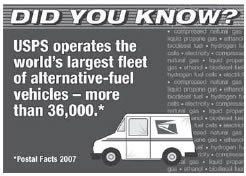Chapter 4 Our Operations
Equipment Design
The Postal Service has incorporated energy efficient requirements into mail processing equipment designs. New standards such as power consumption, voltage, and temperature impact are now being reviewed as part of postal procurement procedures. The Flats Sequencing Sorter is the first major purchase in which these new requirements were used. In addition, when procuring energy consuming products, ENERGYSTAR® and FEMP-designated products will be used where practicable.
Fuel Reduction
The Postal Service delivers to approximately 148 million delivery points each day, and its outreach grows by almost 2 million delivery points per year, making continued reduction of fuel consumption vital. By optimizing its postal-owned fleet and seeking out the best-value available in contract transportation, the Postal Service is reducing miles driven to better manage fuel usage.
The organization continues to monitor key performance indicators for fuel consumption in air and ground transportation. The Surface Visibility program ensures all available mail containers are on the correct trucks. Advanced software applications and other technology are able to map more fuel efficient routes and monitor truck utilization to ensure optimal assignment of ground volume, which reduces emissions from air transportation.
Alternative Fuel Vehicle Program

The Postal Service operates the nation’s largest alternative fuel-capable fleet, including more than 36,000 E-85 flex-fuel vehicles that can operate on gasoline, E-85, or any mixture of the two fuels. The Postal Service acquired 5,856 additional vehicles that can operate on cleaner-burning ethanol (E85) fuel. The Postal Service worked with the U.S. Department of Energy National Renewable Energy Laboratory and Clean Cities Program to determine the best places to place the new E85 vehicles. A database also was developed to reposition vehicles to the Midwest and other areas where fuel is available. In addition, the Postal Service provided technical support to districts that already have E85 vehicles and fuel infrastructure. The organization is now positioned to increase E85 fuel use while effectively and efficiently delivering mail. In June, the Postal Service received the White House Closing the Circle Award for its support of alternative fuel vehicles and alternative fuels in Minnesota.
Water Management
The Water Management program was formed to meet environmental standards for pollutant discharges, storm water runoff, and safe drinking water. It also supports efforts to minimize water usage. An overall water management strategy has been developed to ensure compliance with the requirements of the Clean Water and Safe Drinking Water Acts. In addition, Vehicle Maintenance Facilities will continue the policy of “zero pollutants” in the discharge from washing vehicles. Contracts include provisions to capture runoff and use environmentally-preferable products.
Asbestos Management
The national Asbestos Management Program policy documents were updated and strengthened. District asbestos program coordinators were identified. Employees were trained in the latest asbestos identification and management techniques and in collecting asbestos-related facility documents and placing them in the Postal Service Environmental Management Information System.
ENVIRONMENTAL ACHIEVEMENTS
The Postal Service’s approach to improving its “environmental footprint” is built on the principle of integrating environmental activities within day-to-day operations and engaging every employee to take ownership and responsibility. By working with mailers to reduce undeliverable mail, saving customers unnecessary trips, expanding the use of recycled and recyclable products, and minimizing potentially hazardous and toxic materials, the Postal Service accomplishes its mission while leading the way in environmental stewardship. Environmental activities within the Postal Service resulted in White House and EPA awards, but also provided coordination and support for Sustainability initiatives that included new environmentally preferable packaging, greenhouse gas emissions inventory and the environmental footprint of mail.
Cradle to Cradle Certification
The Postal Service is dedicated to helping mailers go green. In 2007, its free Priority Mail and Express Mail shipping supplies were redesigned, achieving Cradle to Cradle certification. The Postal Service is the nation’s first shipping company to achieve this certification standard which establishes 39 criteria on toxicity, renewable energy, water use, recyclability, and other factors affecting human and environmental health. Cradle to Cradle certification assures that the packaging is manufactured to avoid harming the environment even after its useful life. Based on the annual recycled content of new packaging, more than 15,000 metric tons of carbon equivalent emissions will now be prevented each year. The Postal Service has begun to expand Cradle to Cradle to additional packaging and similar green initiatives throughout its supply chain.